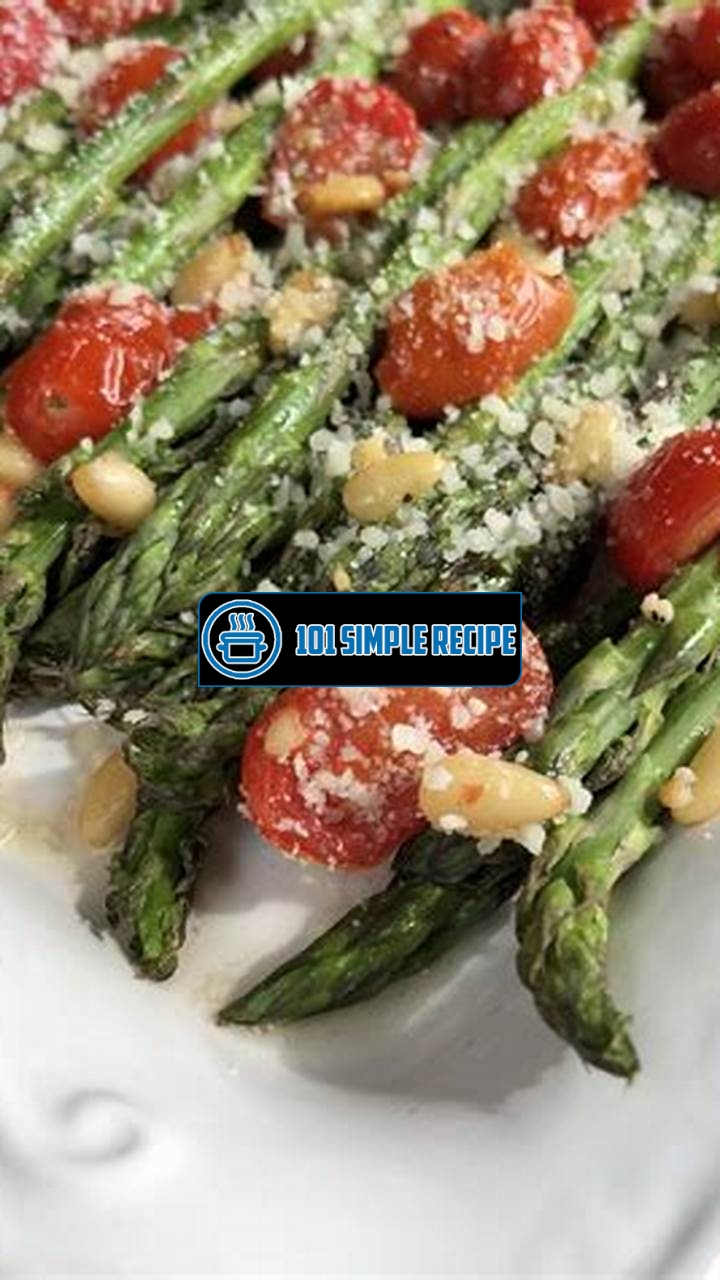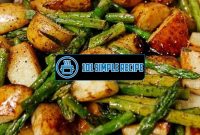If you’re looking for a delicious and healthy side dish to accompany your meal, look no further than this incredible baked asparagus recipe. Not only is asparagus a versatile vegetable that can be prepared in various ways, but it also offers numerous health benefits. With its vibrant green color and tender flavor, asparagus is the perfect addition to any dinner table. In this article, we will guide you through the process of making the best baked asparagus, resulting in a dish that is flavorful and perfectly cooked. Get ready to impress your family and friends with this delightful side dish option!

The Versatility of Baked Asparagus
Asparagus is a delightful vegetable that can be cooked in various ways. One of the most popular methods is baking, which brings out its delicious flavor and tender crispness. In this article, we will explore the versatility of baked asparagus and discover the different ways you can prepare and enjoy this delectable side dish. Whether you prefer roasting, grilling, or wrapping it in prosciutto, there are numerous ways to elevate the taste of asparagus to new heights.
Roasting: A Classic Cooking Method
Roasting asparagus is a classic and foolproof way to bring out its natural flavors. To start, preheat your oven to 400°F (200°C). Trim the woody ends of the asparagus spears and spread them out in a single layer on a baking sheet. Drizzle with olive oil, sprinkle with salt and pepper, and toss to coat evenly. Place the baking sheet in the oven and roast for about 15 minutes, or until the asparagus is tender yet still crisp.
Pro Tip: For an added twist, you can sprinkle grated Parmesan cheese or lemon zest on top of the asparagus before roasting. This will give it a delightful tangy flavor and a touch of elegance.
Grilling: Adding a Smoky Flair
Grilling asparagus takes it to a whole new level, infusing it with a smoky flavor that pairs perfectly with its natural earthiness. Preheat your grill to medium-high heat. Meanwhile, toss the asparagus spears with olive oil, salt, and pepper in a bowl. Place the asparagus directly on the grill grates and cook for about 5-7 minutes, turning occasionally, until it becomes tender and develops those coveted grill marks.
Pro Tip: To enhance the smoky flavor, you can marinate the asparagus in a mixture of balsamic vinegar, garlic, and olive oil for about 30 minutes before grilling. This will impart a deliciously complex taste to the vegetable.
Wrapping in Prosciutto: Elevating the Flavor
If you want to take your baked asparagus dish to the next level, try wrapping it in prosciutto. The saltiness and richness of the cured ham beautifully complement the crispness of asparagus. Preheat your oven to 425°F (220°C). Take a slice of prosciutto and wrap it tightly around each asparagus spear, leaving the tips exposed. Place the wrapped asparagus on a baking sheet and bake for about 10-12 minutes, until the prosciutto becomes crispy and the asparagus is tender.
Pro Tip: For an extra burst of flavor, you can brush the prosciutto-wrapped asparagus with balsamic glaze or sprinkle it with grated Parmesan cheese before baking. This will add a delightful sweetness or a savory richness depending on your preference.
Now that you know the versatility of baked asparagus and the various ways to prepare it, you can impress your family and friends with a delectable side dish that will elevate any meal. Whether you choose to roast, grill, or wrap it in prosciutto, each method brings out unique flavors that will leave your taste buds craving for more. So go ahead, experiment with these techniques, and savor the irresistible deliciousness of baked asparagus!
Nutritional Benefits of Baked Asparagus
When it comes to finding the perfect side dish that not only adds flavor to your meal but also provides a myriad of health benefits, look no further than baked asparagus. This versatile vegetable is not only delicious but also packed with essential nutrients that can boost your overall well-being. Let’s explore the incredible health advantages that baked asparagus offers.
Rich in Vitamins and Minerals
Baked asparagus is a powerhouse of vitamins and minerals that are essential for maintaining good health. It is especially rich in vitamins A, C, E, and K. Vitamin A promotes healthy vision and supports a strong immune system. Vitamin C acts as an antioxidant, protecting your cells from damage caused by harmful free radicals. Vitamin E is known for its anti-inflammatory properties, and vitamin K plays a key role in blood clotting and bone health. By including baked asparagus in your diet, you can ensure that your body receives a wide range of essential nutrients.
An Excellent Source of Fiber
One of the biggest nutritional advantages of baked asparagus is its high fiber content. Fiber is essential for maintaining a healthy digestive system and promoting regular bowel movements. It also helps to keep you feeling full and satisfied after a meal, which can aid in weight management. By incorporating baked asparagus into your diet, you can increase your daily fiber intake and support a healthy digestive tract.
Loaded with Antioxidants
Baked asparagus is loaded with antioxidants that can help protect your body against oxidative stress. These antioxidants, such as glutathione, are known to neutralize harmful free radicals in the body and reduce the risk of chronic diseases. Antioxidants play a crucial role in maintaining overall health and preventing cell damage. By regularly consuming baked asparagus, you can equip your body with an extra dose of these powerful antioxidants.
In conclusion, baked asparagus not only adds flavor and texture to your meals but also offers a wide range of nutritional benefits. From being rich in vitamins and minerals to being an excellent source of fiber and loaded with antioxidants, this vegetable should definitely be on your plate. So, next time you are looking for a perfect side dish, consider baked asparagus and enjoy both its delicious taste and health advantages.
Choosing the Perfect Asparagus
When it comes to preparing baked asparagus, selecting the best quality asparagus is essential. The right choice will ensure that your side dish comes out perfectly cooked and delicious. In this section, we will guide you through the process of choosing the perfect asparagus to elevate your dishes to new heights.
Inspecting the Stalks
Inspecting the stalks is the first step in selecting the best asparagus for your baked dishes. Start by looking for firm and straight stalks. Avoid any asparagus with wilted or soft stalks, as they indicate that the vegetable may be outdated and not at its peak freshness.
Additionally, pay attention to the color of the stalks. Ideally, the asparagus should have greenish-purple tips and a vibrant green color throughout the rest of the stalk. This indicates freshness and guarantees a flavorful and enjoyable eating experience.
Remember, appearances aren’t everything. Gently squeeze the bottom part of the stalks to ensure they have a slight resistance. If they feel mushy or overly tender, it’s a sign that the asparagus is past its prime and won’t yield satisfying results when baked.
Looking for Freshness
Freshness is a vital factor when it comes to choosing asparagus. To determine freshness, take a close look at the cut ends of the stalks. They should be moist and not dried out. Moist ends are indicative of asparagus that has been recently harvested and is bursting with flavor.
If you have access to asparagus with intact root ends, that’s even better. Asparagus that still has its roots attached is likely to be even fresher than the pre-packaged ones, which have already been trimmed. The roots help to keep the asparagus nourished and maintain its optimal flavor and texture.
Furthermore, ensure that the asparagus has a minimal amount of shriveled or dried-up parts. These are signs that the vegetable may have been sitting around for too long and won’t provide the best taste and texture when baked.
Considering Size and Thickness
Size and thickness play a crucial role in determining the tenderness and texture of the asparagus after baking. While personal preferences may differ, selecting asparagus with medium-sized stalks is a safe bet for most baked dishes.
Thicker asparagus stalks tend to be more fibrous and may require longer cooking times to achieve the ideal tenderness. On the other hand, thin stalks can become overly soft or even mushy when baked. Medium-sized stalks strike the perfect balance, resulting in asparagus that is tender yet still has a pleasant bite.
Consider the intended use of the asparagus when choosing the thickness. If you plan to wrap the asparagus in bacon or use it as a side dish, medium-sized stalks are versatile and will work well in various recipes.
By carefully selecting asparagus with firm stalks, vibrant colors, optimal freshness, and the right size and thickness, you can ensure that your baked asparagus dishes turn out to be the best they can be. So, head to your local market armed with these expert tips and choose the perfect asparagus to elevate your culinary creations.
Preparing Asparagus for Baking
Master the art of prepping asparagus to achieve optimal taste and texture. By following these simple steps, you can create the best baked asparagus dish that will be a perfect side for any meal.
Trimming the Tough Ends
To start preparing asparagus for baking, you need to trim the tough ends. This step is crucial as it ensures that you are left with only tender and delicious asparagus spears. The tough ends are fibrous and woody, and they can make the asparagus less enjoyable to eat.
Begin by holding an asparagus spear at both ends, then gently bend it until it snaps. This natural breaking point indicates where the tough end starts. You can discard the tough ends or save them for making vegetable stock or soup.
Washing and Drying
Once you have trimmed the tough ends, it’s time to wash the asparagus spears. This step is essential to remove any dirt or debris that may be present on the asparagus. Place the spears in a colander and rinse them under cold running water, making sure to give them a gentle rub to remove any stubborn dirt.
After washing, it’s important to dry the asparagus thoroughly. Excess moisture can prevent the asparagus from roasting properly and may result in a soggy texture. Pat the spears dry with a clean kitchen towel or paper towels.
Optional Seasoning and Marinades
While baked asparagus is delicious on its own, you can enhance its flavor with optional seasoning and marinades. Experiment with different combinations to find your favorite.
For a simple seasoning, drizzle the asparagus spears with olive oil and sprinkle them with salt and pepper. Toss them gently to evenly coat them with the seasonings. You can also add minced garlic or grated Parmesan cheese for extra flavor.
If you prefer a marinade, mix together olive oil, lemon juice, minced garlic, and your choice of herbs. Marinate the trimmed asparagus spears in this mixture for at least 30 minutes to allow the flavors to infuse.
Remember to adjust the seasonings and marinade quantities according to your taste preferences and the quantity of asparagus you are baking.
By following these steps, you can prepare asparagus for baking like a pro. The trimmed and washed asparagus, along with the optional seasonings, will result in a perfect side dish that is flavorful and healthy. Enjoy your best baked asparagus creation!
Baking Asparagus to Perfection
Get ready for culinary excellence by uncovering the secrets to perfectly baked asparagus.
Temperature and Cooking Time
To achieve the best baked asparagus, it is crucial to pay attention to the temperature and cooking time. You want to strike the perfect balance to ensure the asparagus is cooked to perfection without becoming soggy or overcooked.
For tender asparagus with a slight crunch, preheat your oven to 425°F (220°C). This higher temperature allows the asparagus to cook quickly, preserving its natural flavors and vibrant green color. Arrange the asparagus on a baking sheet in a single layer. This ensures even cooking and prevents overcrowding, leading to uneven results.
The cooking time for asparagus can vary depending on the thickness of the spears. Generally, thinner asparagus will cook faster than thicker ones. A good rule of thumb is to bake the asparagus for 10-15 minutes. Keep a close eye on it to avoid overcooking. You want the asparagus to be tender with a slight bite.
️ Tip: If you prefer a softer texture, you can increase the cooking time by a few minutes. However, be cautious not to overcook the asparagus, as it can become mushy and lose its flavor.
Enhancing Flavor with Seasonings
While asparagus is delicious on its own, you can elevate its flavor with the right seasonings and spices. Consider adding a touch of olive oil or melted butter to enhance its natural richness. Sprinkle some salt and pepper for a classic taste, or experiment with other herbs and spices to suit your palate.
One popular seasoning option is garlic. Minced garlic cloves can be mixed with the olive oil or butter before tossing the asparagus in the mixture. The garlic infuses the spears with a delightful aroma and adds a subtle kick to each bite.
Tip: Feel free to get creative with your seasoning choices. Lemon zest, Parmesan cheese, or balsamic glaze can add an extra layer of complexity to the flavor profile of the baked asparagus.
Checking for Doneness
Knowing when the baked asparagus is perfectly cooked is essential to achieve the desired texture and taste. To check for doneness, simply pierce the asparagus with a fork or skewer. It should easily slide through the flesh without much resistance.
An alternative method is to observe the color and texture. The asparagus should have a vibrant green color and a slightly firm texture. It should not appear wilted or limp.
Tip: Remember that asparagus continues to cook even after it is removed from the oven. To prevent overcooking, you can slightly undercook it and allow it to rest for a few minutes. This will ensure the asparagus retains its crispness and vibrant color.
Mastering the art of baking asparagus is a culinary skill worth acquiring. By paying attention to the temperature and cooking time, enhancing the flavor with seasonings, and checking for doneness, you can serve up the best-baked asparagus for a perfect side dish that will impress your guests.
So why wait? Put on your chef’s hat and start experimenting with different temperatures and seasonings to find your signature baked asparagus recipe.
️ Happy cooking!
Frequently Asked Questions
Thank you for taking the time to read our article about the best baked asparagus. We hope you found it helpful and informative. If you have any further questions, please refer to the FAQs below:
| No. | Questions | Answers |
|---|---|---|
| 1. | Can I substitute olive oil with another type of oil? | Absolutely! While olive oil is commonly used in baked asparagus recipes, you can substitute it with other oils such as avocado oil, coconut oil, or even melted butter for a different flavor profile. |
| 2. | How long should I bake the asparagus? | The baking time for asparagus can vary depending on its thickness. Generally, it takes about 15-20 minutes at 425°F (220°C) for medium-sized asparagus spears. Keep an eye on them and adjust the time accordingly to ensure they are tender and slightly crispy. |
| 3. | Can I add other seasonings to the baked asparagus? | Absolutely! While a simple seasoning of salt and pepper works great, you can experiment with other seasonings like garlic powder, lemon zest, Parmesan cheese, or even a sprinkle of your favorite herbs for added flavor. |
| 4. | Can I use frozen asparagus instead of fresh? | Fresh asparagus is recommended for the best texture and flavor. However, if you only have frozen asparagus, make sure to thaw it completely and pat it dry before baking to avoid excess moisture and ensure a crispy result. |
| 5. | Can I make this recipe ahead of time? | While it’s best to enjoy baked asparagus right after it’s cooked for optimal flavor and texture, you can prepare the asparagus in advance by trimming and seasoning it. Store it in an airtight container in the refrigerator until you’re ready to bake. Just keep in mind that the asparagus may lose some of its crispness if made too far in advance. |
| 6. | What are some delicious serving suggestions for baked asparagus? | Baked asparagus makes a great side dish for a variety of meals. It pairs well with grilled chicken or steak, roasted salmon, or as a topping for salads. You can also serve it with a drizzle of lemon juice or a sprinkle of Parmesan cheese for extra flavor. |
Thank You for Reading!
We hope this article has inspired you to try the best baked asparagus recipe. Don’t forget to bookmark our website for more delicious recipes and culinary inspiration. Feel free to visit us again whenever you’re looking for new and exciting dishes to cook. Happy cooking and enjoy your flavorful baked asparagus!
Jump to Recipe
Best Baked Asparagus

Discover the best recipe for perfectly baked asparagus that is tender, crispy, and bursting with flavor. This easy-to-follow recipe will become your go-to side dish for any occasion.
- 1 bunch of fresh asparagus
- 2 tablespoons of olive oil
- Salt and pepper to taste
- Preheat your oven to 425°F (220°C) and line a baking sheet with parchment paper.
- Trim the tough ends of the asparagus spears and place them on the prepared baking sheet.
- Drizzle the asparagus with olive oil, then season with salt and pepper to taste. Toss them lightly to ensure even coating.
- Place the baking sheet in the preheated oven and bake for 15-20 minutes, or until the asparagus is tender and slightly crispy.
- Remove the baked asparagus from the oven and transfer to a serving dish. Serve immediately and enjoy!
- If you have any leftovers, store them in an airtight container in the refrigerator for up to 2 days. Reheat gently in the oven or microwave before serving.






